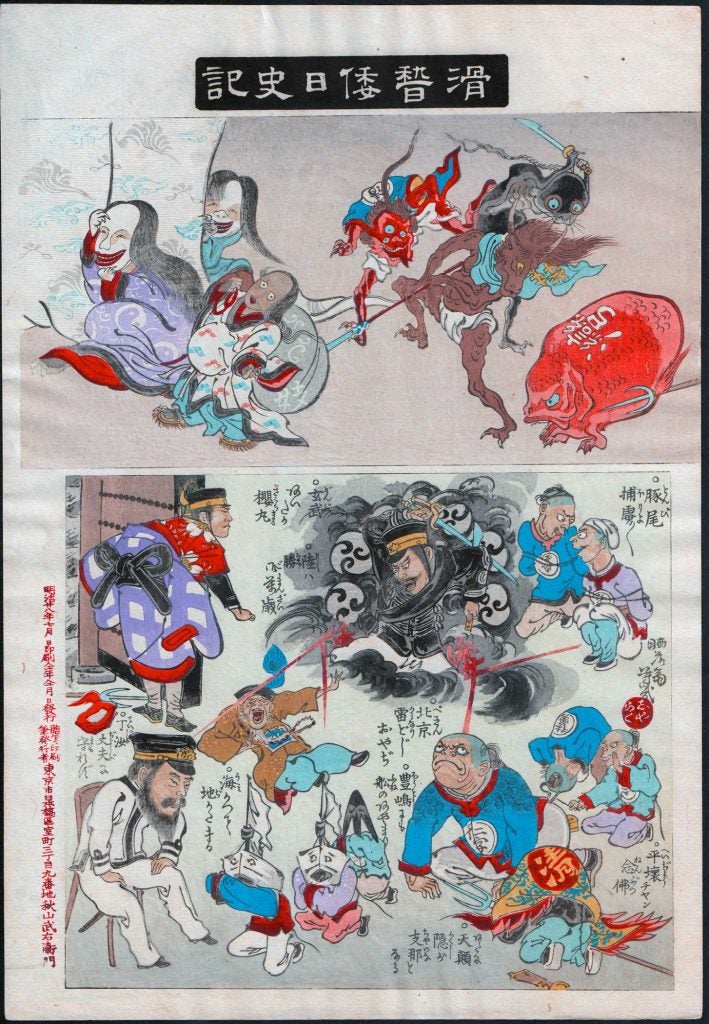
1895.07.01 Thunder God and Demons
in “Comical Record of Japanese History” (Kokkei Yamato Hishiki)
Meiji 28
Artist: Yoshiiku
Signature: Sharakusai Yoshiiku (Utagawa Yoshiiku, 1833-1904)
artist`s seal: Sharaku
A small note: it is clearer to me today, after working on placing the drawings, that what we generally think of as World War 2 was really two independent wars that merged into an even larger one. The war in the Pacific appears to have been inevitable, with Japan as the rising power in the East. The effects of industrialization, which Japan embraced, combined with the likely human failings at the end of the Qing Dynasty in China, which brought down the Empire, changed the balance and emboldened Japan. So as I think about what “pre-war” means for WW2, it is not only the rise of Mussolini’s fascism in Italy and its admiration and embrace by Hitler, it is also the rapidly changing landscape in Japan and China.
Thunder God and Demons, from the series Comical Record of Japanese History (Kokkei Yamato shiki), upper register “Newly Designed Night Parade of a Hundred Demons” (Shin’an hyakki yagyo); lower register “Shinto Rituals and Lantern Parade Celebrating Total Victory” (Zensho shukusai shinji andon)
The growth of Japan as a global power in the late 1800s, particularly with its dominance over China and then Russia, and with global leaders subdividing China, leads directly to the instability of the region and lays the groundwork for conflict in the Pacific as WW2 breaks out.
The First Sino-Japanese War (July 25, 1894 – April 17, 1895), and marked the emergence of Japan as a major world power and demonstrated the weakness of the Chinese empire. The war grew out of the conflict between the two countries for supremacy in Korea.
The war demonstrated the failure of the Qing dynasty’s attempts to modernize its military and fend off threats to its sovereignty, especially when compared with Japan’s successful Meiji Restoration. For the first time, regional dominance in East Asia shifted from China to Japan; the prestige of the Qing dynasty, along with the classical tradition in China, suffered a major blow. The humiliating loss of Korea as a tributary state sparked an unprecedented public outcry. Within China, the defeat was a catalyst for a series of political upheavals led by Sun Yat-sen and Kang Youwei, culminating in the 1911 Xinhai Revolution.
Increasing tensions between Japan and Russia were results of Russia’s unwillingness to compromise and the prospect of Korea falling under Russia’s domination and thus coming into conflict with and undermining Japan’s interests. Eventually, Japan was forced to take action. That would be the deciding factor and catalyst leading to the Russo-Japanese War of 1904–05.
This print, published in July 1895, is part of a propaganda celebration of the Japanese victory over China.
The Kokkei Yamato Hi shiki is a set of nine woodblock prints comprising two connected groups of cartoons and caricatures, in two registers one above the other. The term Yamato Hi in the main title, which appears with a black rectangular cartouche on the upper margin of each sheet, is an ancient name for Japan that defies direct translation.
All the cartoon images that form the upper half of the joined set, subtitled Shin’an hyakki yako (Newly Designed Night Parade of One Hundred Ghosts) are of the so-called hundred ghosts from Japanese folk tales. The images that make up the lower half of the set, subtitled Zensho shukusai shinji andon (Shinto Rituals and Lantern Parade Celebrating Complete Victory), are caricatures of the Sino-Japanese War of 1894-1895, in which the defeated Chinese are mocked and satirized.
The nine prints read as a scroll when placed next to each other. The top inset of this print, the eighth print in the scroll, depicts various yokai, three ghostly women, three monsters and a red fish, with an inscription reading “Bay.” The bottom inset depicts Chinese in various caricatures, including pleading “rat ships,” a Japanese soldier as the Thunder God, a Japanese soldier dressed in kimono, and a Japanese naval officer being entreated by the Chinese “rat ships.” (See the print “Rats in a Bag” by Kiyochika for another use of this caricature).
The Ukiyo’e Caricatures 1842-1905 website of the Department of East Asian Studies – Japanese Studies, University of Vienna provides the following transcriptions of the kanji associated with each caricature in the bottom half of the print:
1. Tonbi horyo horyo
2. Genbu aitaka Sakuramaru
3. Riku wa kachi go-banzai
4. Pekin kaminari doji-oyaji
5. Hoto ni mo fude no ayamari
6. Umi katte ji katamaru
7. Teijo jobu ni mamorezu
8. Heijo chan nenbutsu
9. Atama kakushite shiri kakusazu
The Night Parade of One Hundred Demons is a theme that has captivated the imagination of Japanese artists for centuries. Since the Heian period (794-1185 AD), and perhaps even earlier, Japanese painters have rendered scenes of demonic creatures romping and cavorting at night. Japanese story tellers say that one night each summer all sorts of terrifying beings make their way to the mountains to enjoy themselves with games and amusements.
The publication by Toriyama Sekien of a book on Hyakki Yako in 1776 signaled a new interest in the fantastic theme of Night Parade of One Hundred Demons, which was to last throughout the Edo and Meiji periods. Late in the nineteenth century, the printmaker Utagawa Yoshiiku (1833-1904) produced several imaginative illustrations based on the Night Parade of One Hundred Demons. One of these was his Kokkei Wanisshi-ki (Comical Record of Japanese History), which employs the theme of 100 demons to comment on contemporary Japanese military actions in China.




